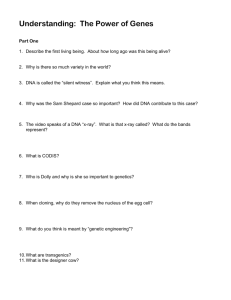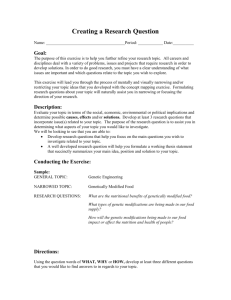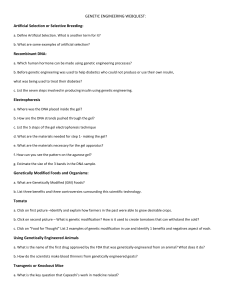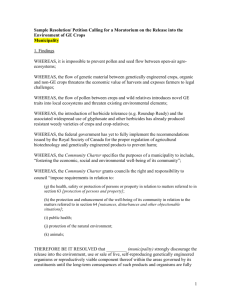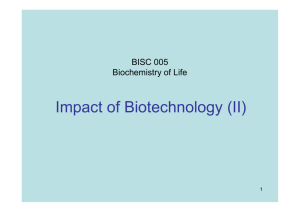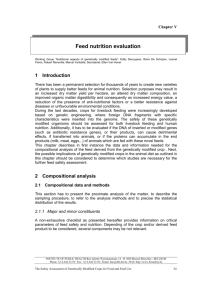Lesson 20: Benefits of Transgenic Organisms (3
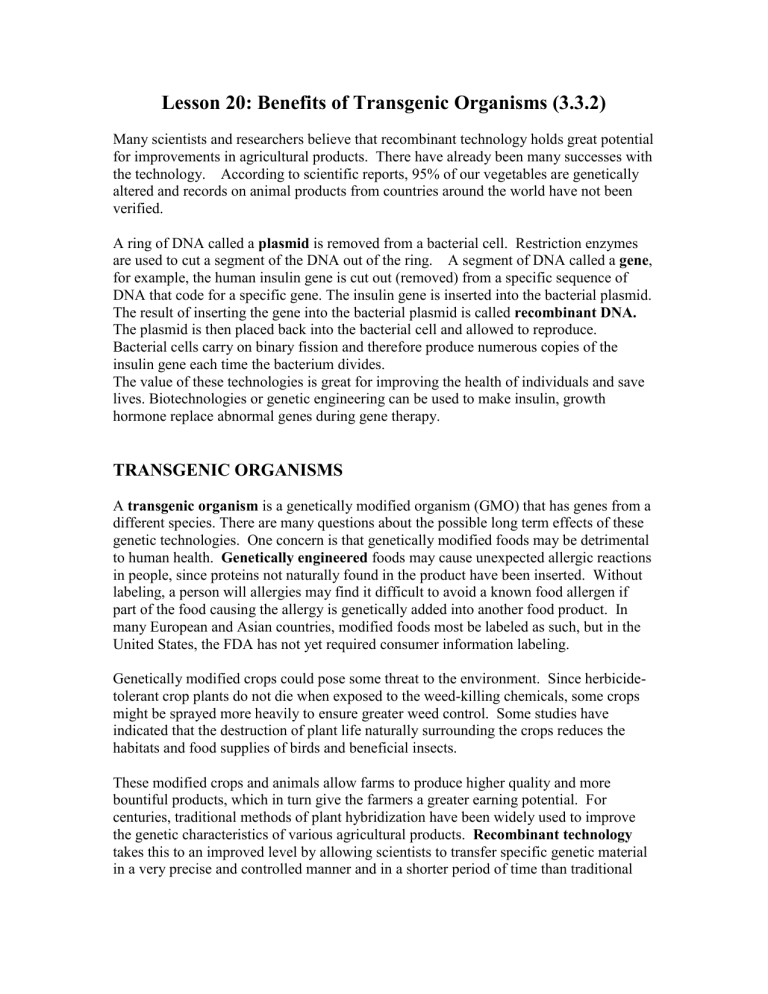
Lesson 20: Benefits of Transgenic Organisms (3.3.2)
Many scientists and researchers believe that recombinant technology holds great potential for improvements in agricultural products. There have already been many successes with the technology. According to scientific reports, 95% of our vegetables are genetically altered and records on animal products from countries around the world have not been verified.
A ring of DNA called a plasmid is removed from a bacterial cell. Restriction enzymes are used to cut a segment of the DNA out of the ring.
A segment of DNA called a gene , for example, the human insulin gene is cut out (removed) from a specific sequence of
DNA that code for a specific gene. The insulin gene is inserted into the bacterial plasmid.
The result of inserting the gene into the bacterial plasmid is called recombinant DNA.
The plasmid is then placed back into the bacterial cell and allowed to reproduce.
Bacterial cells carry on binary fission and therefore produce numerous copies of the insulin gene each time the bacterium divides.
The value of these technologies is great for improving the health of individuals and save lives. Biotechnologies or genetic engineering can be used to make insulin, growth hormone replace abnormal genes during gene therapy.
TRANSGENIC ORGANISMS
A transgenic organism is a genetically modified organism (GMO) that has genes from a different species. There are many questions about the possible long term effects of these genetic technologies. One concern is that genetically modified foods may be detrimental to human health. Genetically engineered foods may cause unexpected allergic reactions in people, since proteins not naturally found in the product have been inserted. Without labeling, a person will allergies may find it difficult to avoid a known food allergen if part of the food causing the allergy is genetically added into another food product. In many European and Asian countries, modified foods most be labeled as such, but in the
United States, the FDA has not yet required consumer information labeling.
Genetically modified crops could pose some threat to the environment. Since herbicidetolerant crop plants do not die when exposed to the weed-killing chemicals, some crops might be sprayed more heavily to ensure greater weed control. Some studies have indicated that the destruction of plant life naturally surrounding the crops reduces the habitats and food supplies of birds and beneficial insects.
These modified crops and animals allow farms to produce higher quality and more bountiful products, which in turn give the farmers a greater earning potential. For centuries, traditional methods of plant hybridization have been widely used to improve the genetic characteristics of various agricultural products. Recombinant technology takes this to an improved level by allowing scientists to transfer specific genetic material in a very precise and controlled manner and in a shorter period of time than traditional
methods. For example, in plant crops the characteristics of pest resistance and improved product quality are highly desirable.
CLONING
Cloning is the creation of genetically identical organisms. The process includes removing the nucleus of the recipient cell and replacing it with the nucleus of the donor cell, and then the altered cell is implanted into the host organism. The cloning of Dolly the sheep from a somatic cell of an adult sheep created great debate about the possibility of cloning humans. The possible benefits of human cloning include allowing a childless couple to have a child, creating tissues for transplantation that would not be rejected by their host and using genetically altered cells to treat people with Alzheimer’s or Parkinson’s, both diseases caused by the death of specific cells within the brain. Another application is to create therapeutic proteins, like
OTHER MODIFIED ORGANISMS
These modified crops and animals allow farms to produce higher quality and more bountiful products, which in turn give the farmers a greater earning potential. For centuries, traditional methods of plant hybridization have been widely used to improve the genetic characteristics of various agricultural products. Recombinant technology takes this to an improved level by allowing scientists to transfer specific genetic material in a very precise and controlled manner and in a shorter period of time than traditional methods. For example, in plant crops the characteristics of pest resistance and improved product quality are highly desirable.
Recombinant technology has already resulted in improved strains of corn, soybeans and cotton. The desirable genes inserted into the plant’s DNA enable crops to resist certain insects or tolerate herbicides used to kill weeds. These improvements also enable farmers to reduce the use of chemicals, which reduces costs for the farmers, as well as helping to reduce environmental damage and runoff pollution. Rot-resistant tomatoes have been made possible by agricultural biotechnology. This improved variety allows grocery stores to offer naturally vine-ripened tomatoes instead of tomatoes that were picked green and artificially ripened on their way to the store.
Some improved products show promise for global impact on the problem of malnutrition.
Researchers working in cooperation with the International Rice Research Institute have used genetic engineering to develop an improved variety of rice. This hybrid “golden rice” has been designed to overcome Vitamin A deficiency and to combat iron-deficiency anemia. A diet containing this improved rice could prevent blindness in millions of children in Third World countries. Another product in development is a variety of rice that will grow in the 33 million acres of land in China that have salty soil.
The term, genetic pollution or uncontrolled hybridization , is used to describe when, in nature, a genetically modified and non-genetically modified plant cross pollinate via by wind, birds and insects. Also, farmers who want to grow non-genetically modified crops may have a hard time avoiding genetic pollution if their farms are located near fields with genetically modified plants.
Lesson 20 Review: Benefits of Transgenic Organisms (3.3.2)
A. Define the following terms.
plasmid cloning
(GMO) genetically modified organism recombinant DNA uncontrolled hybridization transgenic organism
B. Choose the best answer
1. What is a circular piece of DNA used to clone a desired gene?
A.
plasmid C. GMO
B.
DNA fingerprint D. protein injections
2. What technologies are used to genetically modified organisms?
A.
plasmid C. biotechnology
B.
DNA fingerprinting D. restriction analysis
3. Which organism has been genetically modified?
A.
bacterium with an inserted insulin gene
B.
extremely large grapefruit
C. “Dolly”
D. small blueberries
4. Which is a benefit of genetically modified organisms that is currently used?
A.
to make natural human insulin
B.
to restore cell damaged by UV rays
C. to make corn grow taller
D. to test man’s ability to alter nature
C. Complete the following exercises
1. Give an example of an advance in biotechnology that you have heard about in the news or
read about in this chapter. Explain the benefits of the application of biotechnology.



